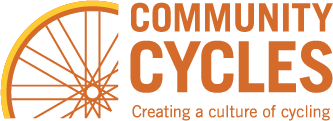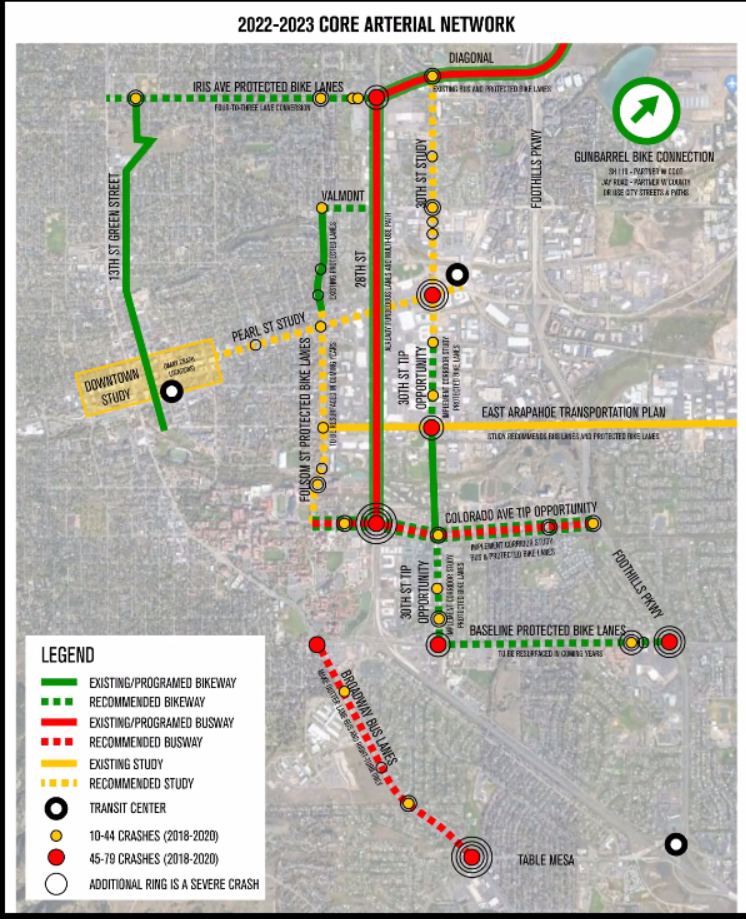In their annual retreat, Boulder City Council voted the “Core Arterial Network (CAN)” a top priority for the 2022 city workplan. The CAN represents a substantial shift in focus for Boulder’s Vision Zero program from primarily focused on neighborhood speed management to planning and projects on key arterials (where most crashes happen), fixing missing links to complete our Low Stress Bicycle Network and a no-brainer transit priority bus lane. The plan for the CAN came from Transportation Advisory Board (TAB) members, who have been long asking for some of these specific projects. TAB’s (and Community Cycles’) request to Council for 2022 was to focus on reducing vehicle miles traveled (VMT) to address both our safety and climate goals. These projects support those goals.
While the adoption and prioritization of the CAN happened over the course of a few frenzied days filled with many conversations with Council members, TAB members and Transportation staff – and supported by many letters from Community Cycles members and partner organizations – the groundwork for this victory was years in the making.
The Community Cycles Advocacy Committee (CCAC) has been working in the trenches for over ten years. We meet with city staff, boards and commissions and elected officials regularly working on the details to make our city’s transportation system safer and more accommodating for people who ride bikes. We review private development plans, every street plan, planning documents, city standards and policies looking for how they can better serve bicyclists, make our streets safer for all modes and encourage more people to walk, bike and take transit. This constant presence – backed by support for our thousands of members – has led to adoption of Vision Zero, the Low Stress Walk & Bike Network, the protected bike lanes we have today, the bike/bus shelters, more bike parking (though not enough), new multi-use paths and underpass infrastructure, changes and updates in policies and procedures, and the 20 mph speed limit on residential streets, in addition to hundreds of minor tweaks in public and private projects and roads that improved the safety of things like curb cuts, sidewalk ramps, bike access and more.
But this victory still remains a big deal. It represents a major shift in focus for the Transportation Department and City Council. This is the first City Council to be elected on a pro-bike agenda and they have shown a great willingness to follow through on those campaign promises. That is extraordinary and revolutionary for Boulder. While previous City Councils have sometimes been supportive of bicycling, this is the first Council to say, “We understand that transportation and climate change are intrinsically linked. We understand that to reduce VMT, we must make the hard political choices that make bicycling and transit more attractive, while having an impact on single occupancy vehicle use.”
What’s next? It is Community Cycles’ (along with TAB) job to make sure the CAN is quickly implemented. We don’t have time for long corridor studies and in fact, the Council directive lays out a timeline for getting these protected bike lanes built. Community Cycles is also looking to accelerate some policy and planning processes that we feel will allow safer designs from the get-go – namely the Design Construction Manual rewrite to include more chapters and make official the languishing Signals Management Plan. We’d also like to see the way in which parking policy is set (and by which department) so that parking is thought of as more a part of our transportation system and less as a city revenue generator. This will allow us to modernize our parking policy so it can work hand in hand with our land use and climate policies.
How can you help make all these great things for bicyclists a reality? JOIN COMMUNITY CYCLES!
Nothing speaks louder to our elected officials than our membership numbers. Council members say they listen to Community Cycles because we are informed and we represent thousands of members. The more members Community Cycles has, the louder our voice and the greater chance that we can make the many changes- large and small, in policies and on the ground – to make our community safer and a more pleasant place to ride a bicycle. JOIN TODAY

